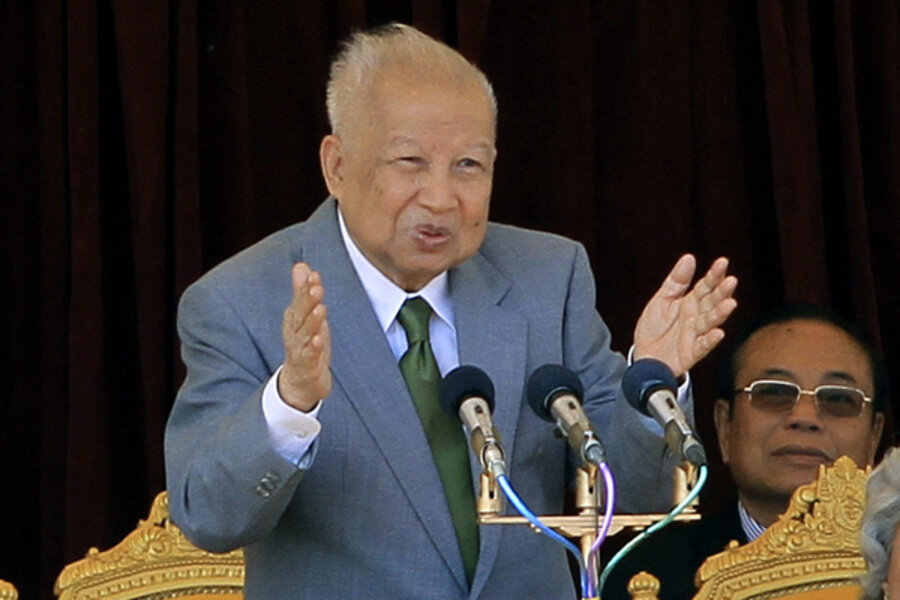Cambodia's political Houdini, former King Sihanouk, dies
Loading...
| Seoul, South Korea
Whether ruling as king or prince, Norodom Sihanouk liked to call Cambodia an “oasis of peace” surrounded by warring nations. He failed, however, to keep his country from enduring one of the cruelest dictatorships of modern times.
In a lifetime dedicated to fending off assaults on Cambodia by foreign interests, Mr. Sihanouk survived power shifts at the heart of the greater power struggle for control of a portion of Southeast Asia historically ruled by France as “Indochina.”
When Sihanouk died Monday in Beijing, he held the honorific title of “king father of Cambodia” even though he had left Cambodia eight years earlier for treatment for a variety of illnesses.
The adjective often applied to Sihanouk was “mercurial” to describe his changes of mood and loyalties. The loud-talking, gregarious Sihanouk was revered and beloved by his people.
“He is the father of the nation,” said Cambodian Prince Sisowath Thomico, an adviser to the current king, as flags flew at half mast in Cambodia. And he leaves behind highly divided emotions and memories.
“Whatever he was to Cambodians and foreigners, Sihanouk's death ends a significant, tumultuous, and ultimately tragic era,” says Wayne Corey, a Voice of America correspondent in China at the time.
Sihanouk, born in 1922, the son of King Norodom Suramarit and Queen Kossamak, titular rulers under French colonial authority, was crowned king at age 18. The French, then under the Nazi regime at Vichy, saw him as a puppet who could serve their interests as Japanese rule spread.
Sihanouk, however, campaigned for Cambodia’s independence, which Cambodia won without bloodshed in 1953 while French forces were bogged down in Vietnam. Two years later, he gave the crown back to his father and named himself “prince” – the word by which he was identified until Gen. Lon Nol overthrew him in March 1970.
Before his downfall, Sihanouk let North Vietnam send troops and supplies through Cambodia to South Vietnam while China shipped arms through the Cambodian port of Sihanoukville. He believed the future of the region lay with the communists – and was on his way to Moscow at the time of his ouster.
In this turbulent period, however, Sihanouk did not try to stop periodic cross-border raids by US Special Forces or “the secret bombing” authorized after Richard Nixon succeeded Lyndon Johnson as president in January 1969. Nixon on May 1, 1970, ordered US troops into Cambodia.
This rapid sequence placed Sihanouk on the side of the Khmer Rouge, the Chinese-backed guerrillas whom he had previously tried to suppress. Sihanouk returned to Phnom Penh with his wife Monique after the Khmer Rouge drove out the US-backed regime in April 1975 and remained there for four years.
Sihanouk regained the title of head of state but was powerless to stop the Khmer Rouge from a terror campaign in which 2 million people lost their lives. In fact, a number of his children and close relatives are believed to have been killed while Sihanouk was held under what he said was “house arrest” in the royal palace.
He was not able to leave Phnom Penh again until the Vietnamese invaded Cambodia in December 1978, driving the Khmer Rouge into jungle hideaways. He denounced Vietnam in the UN, then left for North Korea and China. It was a tribute to his knack of courting friends and foes on all sides that he also had a residence in Pyongyang, where he had befriended North Korea’s “Great Leader” Kim Il-sung after breaking off with the US in 1963.
He returned to Cambodia in 1991 and again in 1993 when he again was named “king” after brokering negotiations to bring about peace among feuding factions.
In his later years, Sihanouk connived to preserve royal rule, ensconcing a son, Norodom Sihamoni, as king before leaving for China in 2004. Real power, however, rested with Hun Sen, the prime minister who had once fought with the Khmer Rouge. Mr. Sihamoni and Hun Sen embraced each other as they left to bring back Sihanouk’s remains for a Buddhist state funeral.
Mr. Corey, the journalist, recalls a five-hour press conference that Sihanouk gave after arriving in Beijing. “He played the diplomatic game to the hilt and knew how to get along with prominent foreigners as well as with foreign journalists,” he says. “History will finally judge what he meant to Cambodia.”





